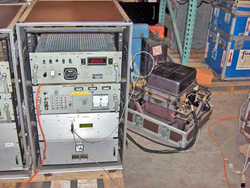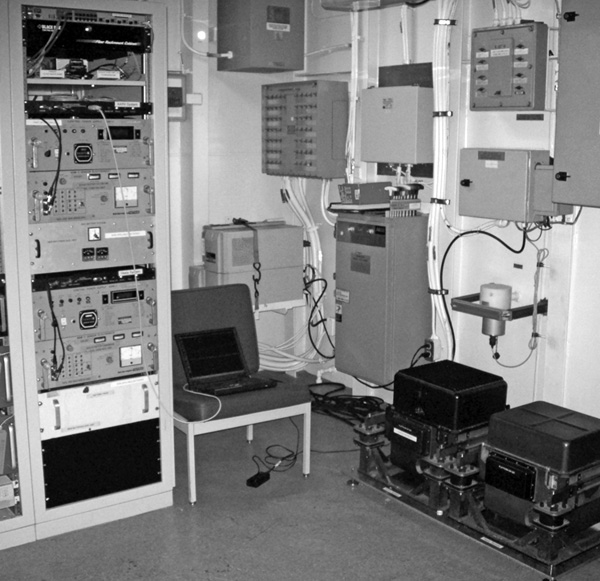Potential Fields Pool Equipment ‘PFPE’ - Ship BGM-3 Gravimeters
Background
In late 2006, an opportunity arose to acquire used BGM-3 gravimeters and spare parts from a commercial survey company, Fugro-Robertson, Inc. It was envisioned that acquisition of these gravimeters would result in permanently installed meters on several UNOLS Class 1 vessels, and that several meters that could be staged and installed on other ships on an as-needed basis (e.g., “pool gravimeters”). In order to take advantage of this opportunity, a group of scientists at University of Alaska at Fairbanks (UAF), Scripps Institution of Oceanography (SIO), and Woods Hole Oceanographic Institution (WHOI) wrote an unsolicited NSF proposal with WHOI as the lead institution to acquire the Fugro gravimeters and spares. That proposal (NSF-OCE-0705964) was funded in 2007 and over the course of the next 2 years, 4 gravimeters were permanently installed on the USCGS Healy, R/V Knorr, and R/V Revelle. This increased the number of permanently deployed BGM-3 gravimeters from two (the systems on the R/V Melville and R/V Marcus Langseth) to six. Two additional gravimeters were designated as pool gravimeters and, since 2008, have been deployed on cruises to the Pacific, Red Sea, and the Arctic.
The acquisition of seven BGM-3 gravimeters in 2007 through the NSF grant significantly increased the number resolved the problem of providing gravimeters to the UNOLS fleet, however it did not provide for the long-term financial and technical support of this instrumentation. To address this need, WHOI initiated a discussion with the marine gravity community and UNOLS ship operators to establish a gravimeter pool to share equipment and technical expertise with the ultimate goal of ensuring that all of the deployed BGM-3 gravimeters are well maintained and supported so that they can obtain high-quality marine gravity data. The pooling of equipment was intended to facilitate the purchase spares and needed repairs to gravimeters throughout UNOLS, thereby reducing the financial costs and logistical burden to the operators and UNOLS as a whole. All of the UNOLS Class 1 ship operating institutions supported this initiative and, in June 2009, the Potential Fields Pool Equipment (PFPE) facility was formed at WHOI.
Available Equipment
Presently the Potential Fields Pool Equipment (PFPE) section of the WHOI-MISO Facility supports the maintenance and operation of nine (9) gravimeters in the UNOLS fleet. Table 1 summarizes the available sensors. Seven (7) of these BGM-3 gravimeters are permanently installed and two (2) are available through WHOI-PFPE for use on other vessels.
Table 1: BGM-3 Gravimeters available to the UNOLS community. Ownership of the gravimeters purchased by NSF has since been transferred to the respective operating institutions.
| Gravimeter | Purchaser | In Service Date | Host Vessel (Operator) | |
| S210* | NSF | 2011 | R/V Thompson (UWash) | |
| S213 | LDEO | 1984 | R/V Marcus Langseth (LDEO) | |
| S218 | NSF | 2007 | R/V Revelle (SIO) | |
| S219 | NSF | 2007 | R/V Knorr (WHOI) | |
| S220 | NSF | 2007 | Pool Gravimeter | |
| S221 | NSF | 2007 | USCGS Healy (UAF) | |
| S222** | NSF | 2007 | USCGS Healy (UAF) | |
| S223 | NSF | 2007 | Pool Gravimeter | |
| S224 | SIO | 1970? | R/V Melville (SIO) |
* Scheduled to be installed in Spring 2011
** Scheduled to be transferred to the ARRV in 2014
On vessels with permanently deployed gravimeters, the sensors are part of the ship's standard cruise data product and available to any PI using the vessel. PIs planning to use the gravimeters as part of their cruise program should inform both the operating institution and PFPE well in advance of the cruise to help ensure any necessary support.
The technicians on the host vessel are responsible for maintaining the gravimeters at sea and conduct weekly and daily systems checks. During science operations, it is the responsibility of the science party to check the gravimeter status on an hourly basis and inform the technicians of any problems. Science is also responsible for verifying the quality of the data while at sea. PIs should plan for this requirement when scheduling watch duties for their cruise.
Data
For permanently installed BGM-3gravimeters, each institution logs gravity data in its own format. The PI should contact the vessel they will be using for the exact formats and data samples. Pool gravimeters are equipped with data logging laptops and PFPE can provide information and data samples. PFPE also maintains Matlab code that can be used for daily quality control checks. PFPE is currently working with the ship operators and the NSF ‘Rolling Deck to Repository’ initiative led by LDEO to establish standard data logging formats and processing software. Scientists are encouraged to contact PFPE for more information and provide feedback on this effort.
PFPE ?Pool? Gravimeters
PFPE maintains 2 BGM-3 gravimeters for use on vessels lacking permanently installed gravimeters. These pool gravimeters on been installed on UNOLS and foreign vessels of varying size and have been deployed on cruises to the Pacific, Red Sea, and the Arctic. PFPE provides all of the necessary equipment, including spares, a land gravimeter for gravity ties, and laptops for data logging.
Planning the shipping and installation of the pool BGM-3 gravimeters requires significant planning because power must be maintained to the sensors at all times, even during shipping. PIs with interest in using these systems are encouraged to contact PFPE as early as possible. Once the cruise dates and ports are known, PFPE will work with the PIs and the vessel operators to coordinate the logistics, including moblization, training and operation, and demobilization. PFPE handles all of the installation logistics, including shipping and on-site training of shipboard technicians. The gear is shipped to the vessel at a convenient port (within the Continental U.S. when possible) and an engineer travels to the ship to install the gravimeter. The mobilization typically takes 3 days with the third day including training and a gravity tie. To facilitate shipping logistics, PFPE may elect to install the gravimeter well in advance of the cruise and/or remove it well after the cruise. Obtaining high-quality gravity data requires accurate ship navigation, speed and bathymetry data. PFPE works with the ship’s technicians to ensure these data feeds are available. The ship's data logging system can be used or science can use PFPE gravity logging software run on laptops provided by PFPE. In the latter case, the ship's data feeds need to be provided over either serial or network data feeds. PFPE will do gravity ties during the mobilization and demobilization. Gravity ties must be performed immediately before and after the cruise and, in the case that the gravimeter is installed or removed significantly before or after the cruise, the shipboard technicians or science party will be trained to perform these ties. PFPE provides all of the necessary information, equipment, and training for these ties. After the cruise, a PFPE engineer will travel to the vessel to perform a final gravity tie, remove the gravimeter, and ship it back to Woods Hole.
Costs
Gravimeters permanently installed on vessels are part of the ship's standard geophysical data acquisition systems sensing and are available to the PIs at no cost. For PFPE pool gravimeters, PIs are responsible for covering the shipping, installation, and removal costs of the gravimeters. Recent mobilization and demobilization costs for Portland, San Diego and St John's, Newfoundland have been in the range of $10-15k. The primary variable in these costs is the travel and shipping to and from the mob/demob locations. For cruises funded by NSF, this is the only cost. For non-NSF funded cruises, a fee of $8,000 per month is applied for each month the PI uses the gravimeter. Installation costs are paid at the time of installation and the monthly fee (if applicable) and removal costs at the end of the cruise. PFPE receives significant support from the National Science Foundation and we appreciate when PIs acknowledge this support in publications resulting from ship BGM-3 data.
Contact Information
To request a pool gravimeter, please fill out the form on the MISO equipment request page: https://www2.whoi.edu/site/miso/request-an-instrument/
For more information on PFPE, contact:
James Kinsey
508-289-3470
jkinsey@whoi.edu
Dan Fornari
508-289-2857
dfornari@whoi.edu

